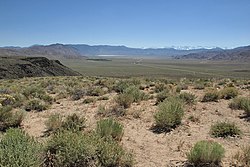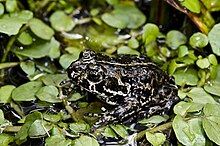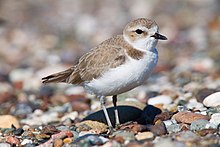Deep Springs, California
Deep Springs | |
|---|---|
 Deep Springs Valley from Gilbert Pass | |
| Coordinates: 37°22′18″N 117°59′06″W / 37.37167°N 117.98500°W | |
| Country | United States |
| Elevation | 5,194 ft (1,583 m) |
Deep Springs (formerly, Deep Spring) is a set of artesian springs in Inyo County, California that are used for irrigation, water supply, and livestock. The springs lie within the treaty territory of the Western Bands of the Shoshone Nation of Indians (Timbisha Band of Western Shoshone Indians). It is located in the northeastern section of Deep Springs Valley, 22 miles (35 km) east of Bishop,[2] 2.6 km (1.6 mi) north of Soldier Pass, and 6.4 km (4 mi) southwest of Chocolate Mountain (formerly Piper Mountain),[3] at an elevation of 5194 feet (1583 m).[1]
The area was originally home to the Deep Springs Valley Paiute prior to Euro-American settlement around the 20th century. Deeps Springs Valley has a semi-arid desert climate, and the springs create an environment with a variety of animal and plant life.
Deep Springs College is located in Deep Springs Valley, although not at the site of the springs. The students of Deep Springs College engage in a program emphasizing labor as a fundamental pillar of their studies. The students participate in a minimum of twenty hours of labor a week: milking cows, irrigating the farm, and learning about the land. The Deep Springs post office operated from 1881 to 1883[2] and 1920 to 1953.[2] The springs, after which the town was named, are now called Buckhorn Springs.[2]

History & Natural Resources
[edit]The lake within the Deep Springs Valley, Deep Springs Lake, is also a rich source of evaporite minerals and mining material. However, the Deep Springs Lake is under-utilized because the nearby Owens Lake provides a more accessible source for mining.[4]
The Deep Springs are used for irrigation for agricultural operations and livestock in the area. There are several levees and ditches surrounding the lake that are presumed to improve the quality of life for grazing livestock and wildlife. The majority of the agriculture in the area is done by the students of Deep Springs College. The natural springs are also the main source of drinking water for the local area and Deep Springs College to meet daily water consumption needs.[5] The springs support all local animal and plant life.
Native People
[edit]
For thousands of years, the Deep Springs Valley Paiute, a distinct subgroup of the Northern Paiute people, inhabited Deep Springs, California. They established traditional cultural practices and separated themselves from other Paiute groups in nearby Owens and Fish Lake valleys.[6] Living in this remote and arid region, they adapted to the environment by developing an expansive knowledge of local plants, water sources, and hunting methods. They lived in the valley long before Euro-American settlers started to move into the area during the 20th century.
The Deep Springs Valley Paiute made use of a strategy called “annual round,” where the movements and activities of a group of people were dependent upon seasonal availability of available resources.[7] During the fall and winter they gather seeds, roots, and pine nuts, and hunt large game, including deer and mountain sheep. Survival involved their ability to adapt to the harsh environment and to efficiently exploit local resources. In particular, it was essential to their food supply that the pine nut harvest provided them with sustenance through their winter months.[7]
Wildlife
[edit]Notable Animal Life
[edit]

The Deep Springs Valley is specifically marked as an "Important Bird Area" by the Eastern Sierra Audubon Society however, the notable wildlife extends to amphibians, insects, and mammals as well.[8] Some notable species include, the Western Snowy Plover (Charadrius alexandrinus nivosus) and the Black Toad (Anaxyrus exsul).[9] The black toad is only found within the Eastern Sierra region, at an estimated population of around 7800-9700. The Deep Springs Valley wetlands are surrounded by desert, making it impossible for the black toad and other native species that rely on water to expand beyond that area.[10] As for the snowy plover and other migratory species, Deep Springs Valley provides a sanctuary of water and resources, as they begin flying south for the fall and winter months. The wetlands surrounding Deep Springs Lake as well as the marshier areas within the valley contribute to a more diverse ecosystem with an otherwise dry and arid climate.
Notable Plant Life
[edit]Deep Springs is also home to an assortment of plants. Around the main circle, there are Lemon Balm (Melissa officinalis) and Mullein (Verbascum thapsus). In rocky areas, there are Beavertail Cactus (Opuntia basilaris), Prince’s Plume (Stanleya pinnata), and Indigo Bush (Psorothamnus arborescens var. minutifolius). On the dry valley floor, there is Fourwing Saltbush (Atriplex canescens) and Hopsage (Grayia spinosa). On the wetter valley floor, there are Rabbitbrush (Chrysothamnus greenei and viscidiflorus), Antelope Bitterbrush (Purshia tridentata var. glandulosa), and Sagebrush (Artemisia tridentata ssp. tridentata).
Climate
[edit]Deep Springs Valley has a semi-arid desert climate with hot, dry summers and cold, dry winters—very similar to surrounding areas.
In the summer, temperatures at the Deep Springs reach maximums around 91.8 °F (33.2 °C) and minimums around 54.1 °F (12.3 °C).[11] In the winter, temperature maximums around 51.3 °F (10.7) and minimums around 7.7 °F (-7.7 °C).[11]
Year-round precipitation is sparse, with an annual total of 6.63 inches (16.84 cm).[11] Despite the low precipitation, occasional summer thunderstorms sometimes bring brief rainfall.[12]
References
[edit]- ^ a b "Deep Springs". Geographic Names Information System. United States Geological Survey, United States Department of the Interior.
- ^ a b c d Durham, David L. (1998). California's Geographic Names: A Gazetteer of Historic and Modern Names of the State. Clovis, Calif.: Word Dancer Press. p. 1159. ISBN 1-884995-14-4.
- ^ "Chocolate Mountain". Geographic Names Information System. United States Geological Survey, United States Department of the Interior.
- ^ "Deep Springs Lake Ecological Reserve". wildlife.ca.gov. Retrieved October 23, 2024.
- ^ "Deep Springs College – Prepare for a life of service". www.deepsprings.edu. Retrieved October 23, 2024.
- ^ "Eastern California Museum | Inyo County California". www.inyocounty.us. Retrieved October 23, 2024.
- ^ a b "Natural History of the White-Inyo Range "d0e33239"". publishing.cdlib.org. Retrieved October 23, 2024.
- ^ "Deep Springs Valley IBA | Eastern Sierra Audubon". esaudubon.org. Retrieved October 22, 2024.
- ^ "Deep Springs Lake Ecological Reserve". wildlife.ca.gov. Retrieved October 22, 2024.
- ^ "Amphibian Conservation - Black Toad". wildlife.ca.gov. Retrieved October 23, 2024.
- ^ a b c "Deep Springs College, California: Climate and Daylight Charts and Data". www.climate-charts.com. Retrieved October 23, 2024.
- ^ "DEEP SPRINGS COLLEGE, CALIFORNIA Period of Record Monthly Climate Summary". wrcc.dri.edu. Retrieved October 23, 2024.
Reference bibliography
[edit]- Waring, Gerald Ashley (1915). Springs of California. U.S. Geological Survey Water Supply Paper. Vol. 338. U.S. Government Printing Office. doi:10.3133/wsp338.


